19 FIT, Pratt, and Parsons 2019 Graduates on Their Collections and the Future of Fashion
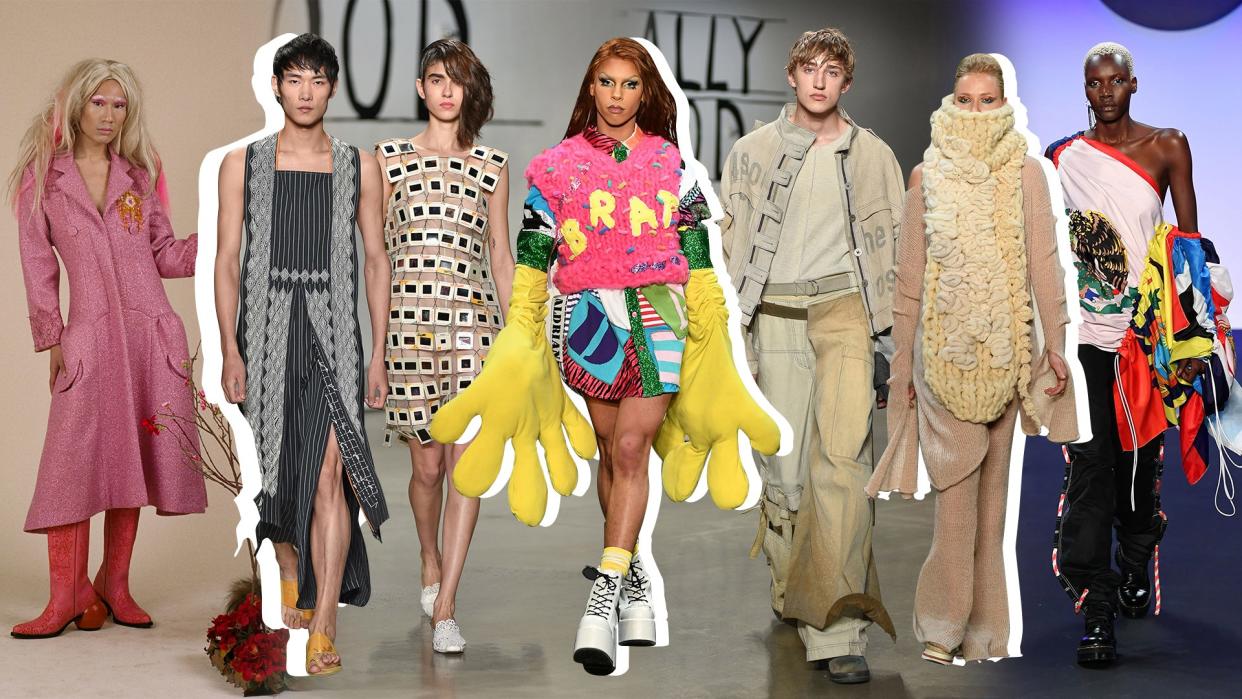
You’ve probably heard the expression, “A dress is just a dress.” This concept has no resonance for the 2019 fashion design graduates from the Fashion Institute of Technology (FIT), Parsons School of Design at The New School, and the Pratt Institute. For them, clothing not only has to look good, it also needs to be made in ways that respect the environment and the workers making the garments. Many want to use their work to represent marginalized communities or other sociopolitical issues they hold dear. Immigration, gender, sustainability, and bootleg culture are just some of their concerns. Personal narratives are woven into several collections, and a number of these graduates have thought beyond retail and and materiality and engaged in collaborative and/or performative arenas. Other have created events or nonprofits that link their garments to the worlds of art and activism.
Meet 19 fashion designers writing the future of fashion.
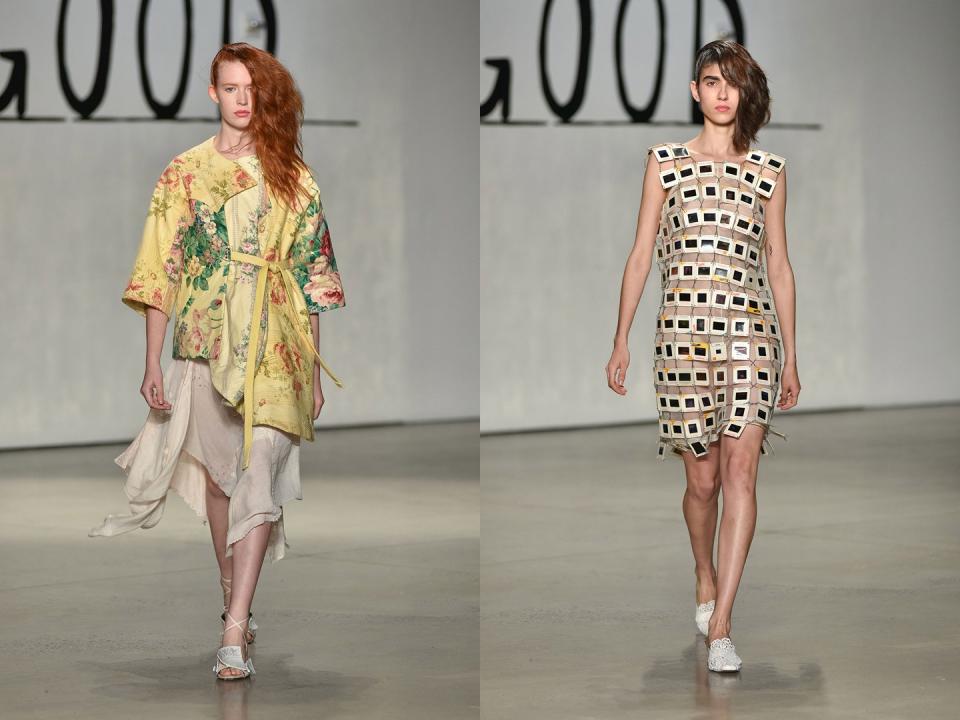
Alanna Josephine Beneroff, from northern New Jersey
School: Pratt Institute
Collection concept: I was inspired by my family home and the collecting/hoarding that occurs there. The garments provide an afterlife for forgotten objects, bringing collected pieces back into a scenario where they can be interacted with and appreciated, through the practice of bricolage—using whatever is on hand to create something new.
Most unusual materials used: Almost every piece is made from vintage or repurposed materials, so there are a few weird ones: old wallpaper remnants; vintage Kodachrome slides; and Capri Sun pouches I collected during middle school.
What do you want to communicate through your work? My work is a balance of preservation and transformation. I want to encourage the stewardship of textile goods and an appreciation of craft. I add evidence of my own hand in each garment, embedding myself into the garments with each stitch.
What issues are most important to you? Sustainability is always my main focus. In my work I intend to do no harm, to create without adding any extra burden on the planet or its people. [I believe in] slow fashion that has an emphasis on craft and quality over quantity.
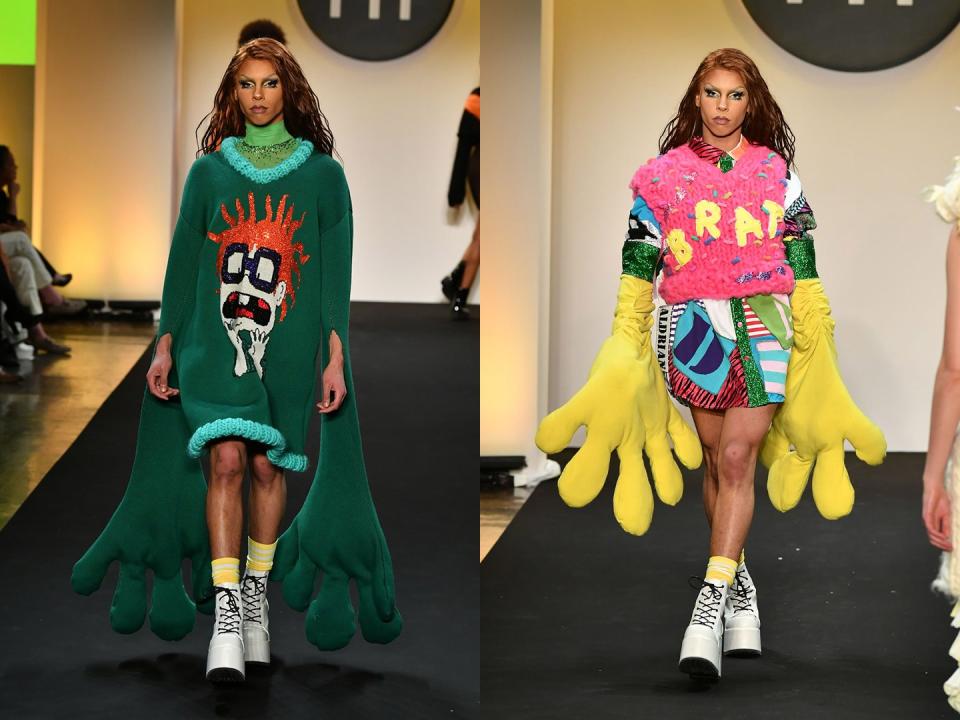
Aldrian Diaz, from Long Island, New York
School: Fashion Institute of Technology
Collection concept: Colorful and whimsical campwear heavily inspired by my late ’90s and early ’00s childhood [and] incorporating children’s hair scrunchies and thousands of Swarovski crystals.
What issues are most important to you? Gender fluidity and inclusivity. My designs are not gendered and can be worn by just about anybody. I never want my designs to be taken too seriously. I think it’s always important to dress for yourself and no one else.
What is the future of fashion? Where no one questions whether or not a garment is intended for their gender, size, or ethnicity. Then [everyone in the] world will be free to express themselves as they please without fear of judgement.
Dream job? It was so amazing watching Serena Tea walking in my work and I would absolutely love to continue designing for drag queens, performers, and the club kid scene for a living.
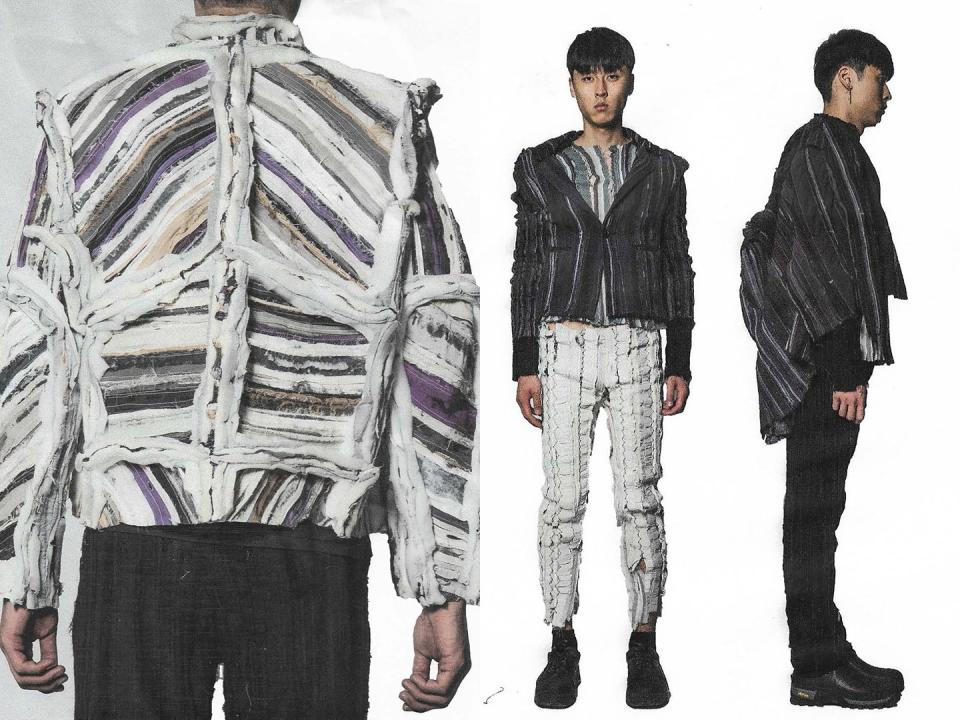
Andrew Davis, from Minneapolis
School: Parsons School of Design at The New School
Collection concept: The collection [was about] processing a loss in my family. It also became an exploration of the new rules you can create when you have limited resources.
What do you want to communicate through your work? Sincerity and integrity. I used a lot of odd and cheap materials in my collection like [tea stirrers], newspapers, and selvage leftovers, but I did my best to push them beyond their initial preconceived end use. A lot of thought was given to what these materials could do, which is a big part of what sustainability means to me.
What is the future of fashion? Collaboration and sharing of resources. My work would be nothing without the generosity of so many others.
Dream job? Let’s aim high and say Chanel Haute Couture.
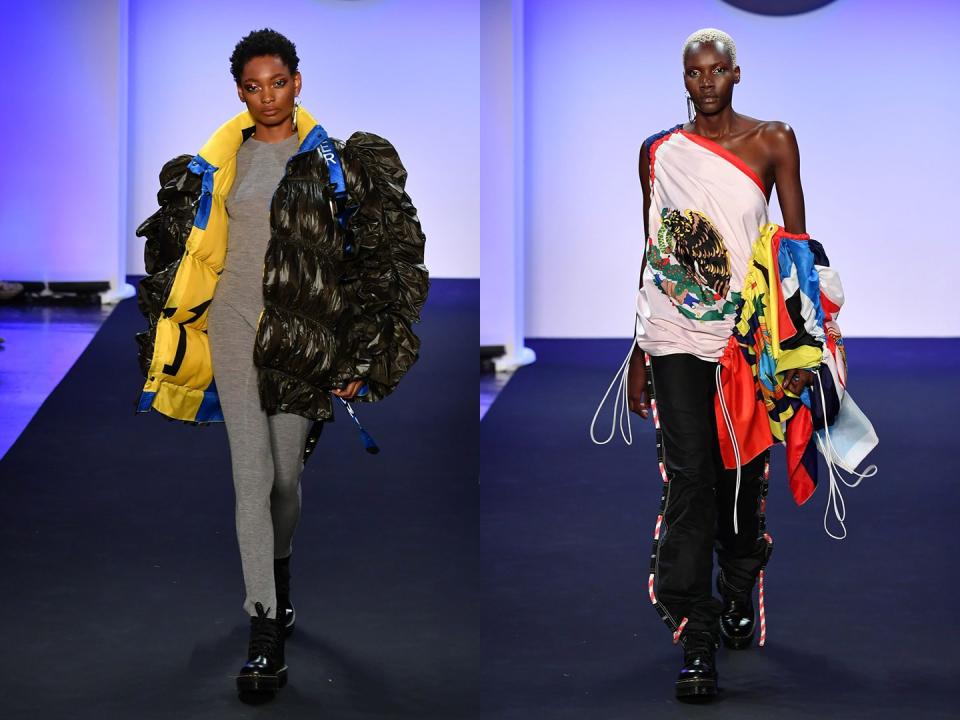
Ariel Clarke, from Queens, New York
School: Fashion Institute of Technology
Collection concept: It started with a series of photos I took last summer of my dad while accompanying him on one of his [building] work sites. My inspirations were my father and his trade, my Barbadian culture, and the topic of current immigration turmoil.
What do you want to communicate through your work? My family, like many others I know, contributes to America being “the land of the free.” The construction sites my dad works on include many men from different countries and the Caribbean islands. I figured if I couldn’t see their representation through the roads they’ve paved and the buildings they have risked their lives to build, I would create a collection incorporating that narrative.
What is the future of fashion? The future of fashion is constantly evolving with the use of new and innovative textiles. It will also involve collaboration between many passionate people.
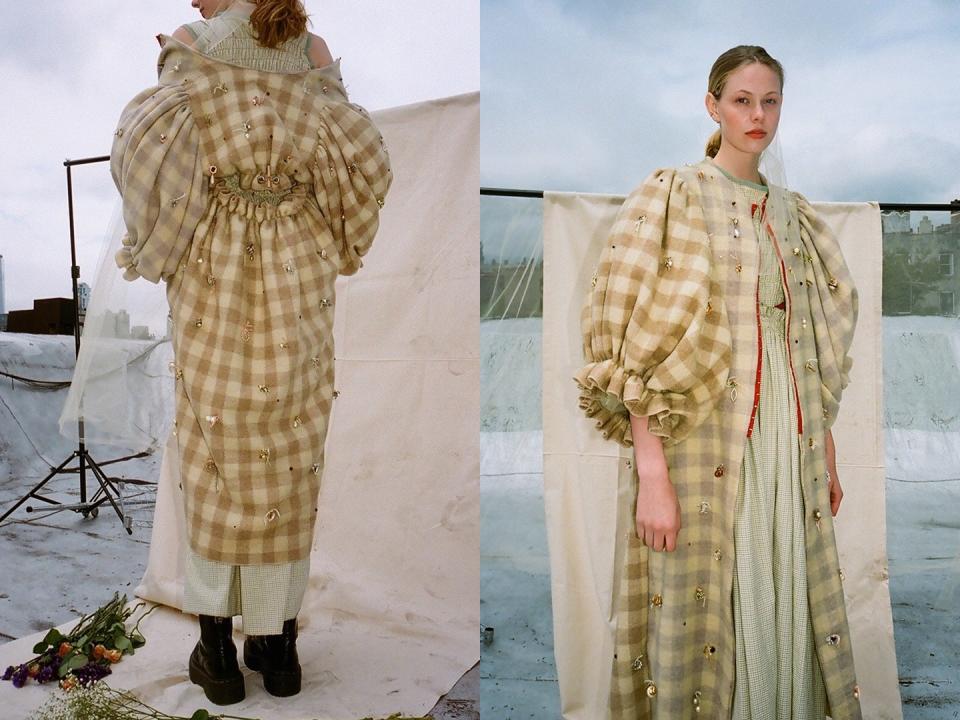
Bella Wynne, from Dallas
School: Fashion Institute of Technology
Collection concept: A commixture between antique, repurposed materials and modern textile technology. Every piece contains a story, a reflection on costume history, and a nod to the surreal.
Most unusual material used: Antique porcelain doll’s eyes.
What do you want to communicate through your work? Sustainability is a huge focus for me. I want my work to show that repurposing vintage and antique textiles can be done in a beautiful and exciting way.
What is the future of fashion? Creating useful and mindful items while still being authentic to yourself. Sustainability is the future of fashion.
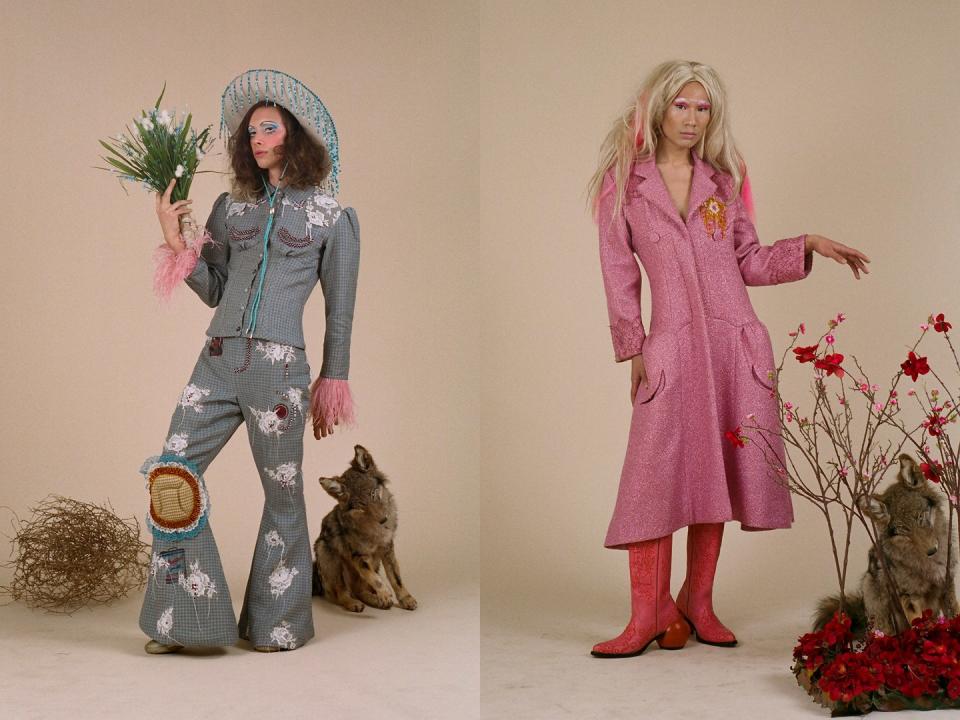
Cassadee Hirsch, from St. Charles, Illinois
School: Parsons School of Design at The New School
Collection concept: To submerge and realign what it means to be a man or woman through the canvas of suiting. My collection aims to reimagine the classic country-western narrative by deconstructing masculine tropes and Americana culture through my Midwestern roots and upbringing.
Most unusual material used: My collection is mostly made out of double Lurex tweed, but I also screen-printed random items I have collected through the years by browsing vintage stores and dumpster diving—items like vintage oilcans, 1950s call cards, and old matchboxes.
What do you want to communicate through your work? That a-gender fashion and genderless suiting can be fun, colorful, and bold.
What is the future of fashion? I think the future of fashion will revolve around smaller brands and designers who have sustainable practices. I also believe that the fashion industry will start to slow down and become more technology based through customization.
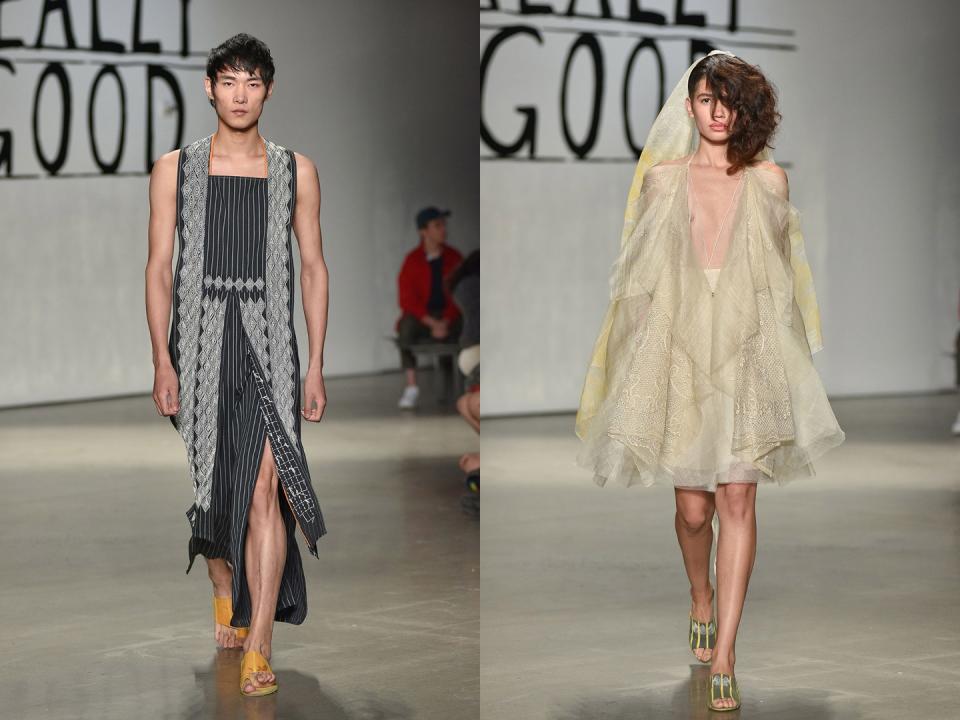
El Quesada, from Los Angeles School: Pratt Institute
Collection concept: I started with heavy research on pre- versus postcolonial traditional Filipino dress, with a lot of references to early pattern-making in the area my family originated from. As I progressed with the textile-heavy collection, the experience of my culture through my family, their stories became the focal point.
Most unusual material used? Piña cloth is an extremely sheer, structured, and lightweight fiber woven from the pulp of pineapples; a family member was able to go in my stead to the Philippines and source the material.
What is the future of fashion? From supporting sustainable companies and wanting to know where their clothes come from to searching for one-of-a-kind pieces and seeing the value in repurposing thrifted threads, I think we’re moving in the right direction to value quality over quantity.
Dream job? To work in an atelier as an apprentice to a very technical niche hand skill. I have a great appreciation for the authenticity of couture and would love to find myself in the position of carrying on these craft traditions.
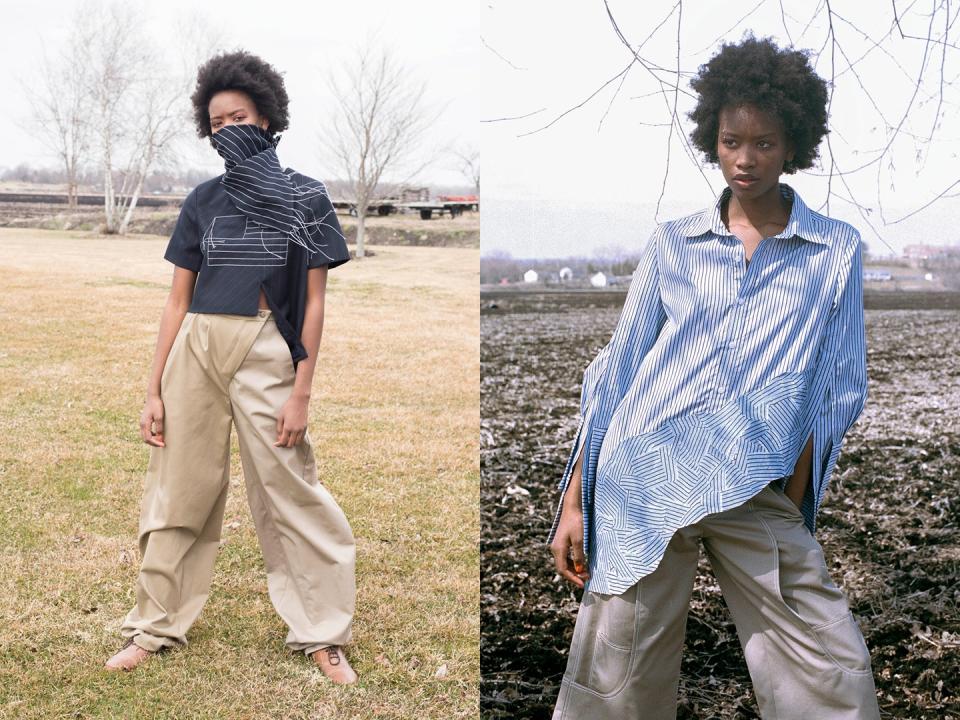
Elie Romero, from Phoenix School: Pratt Institute
Collection concept: This collection is inspired by the current political tension between white America and immigrants, with an ironic clash between uniforms that define the white man and Hispanic immigrant. I was heavily inspired by my parents’ journey to America and the process of the migrant worker, as well as the history of workwear and the badge of delinquency the zoot suit represented.
Most unusual material used: The most unusual material used in the collection is a layer of striped cotton shirting and knitted twine, which is bonded by a layer of clear matte heat press film to create one sturdy and waterproof material.
What issues are most important to you? One of the issues I’m very passionate about is the stigma towards immigrants. America was founded by immigrants for immigrants to live freely and prosper, and I think we have lost sight of that today.
What is the future of fashion? With today’s political climate I think it is important to communicate the stories of those who are oppressed and aren’t given the same opportunities as others. I think fashion should be used as a form of activism and as a way for us to speak out about important issues.
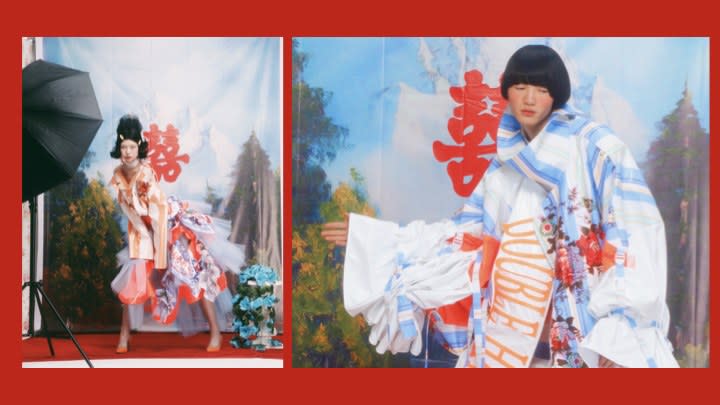
Feiyang Qiao, from Shanghai, China
School: Parsons School of Design at The New School
Collection concept: After my grandma kept haunting me to find a boyfriend based on her list of what an ideal husband [would be], I started to think about the meaning of love and marriage for my generation, and at the same time to criticize the existing dating and wedding culture.
What do you want to communicate through your work? Weddings in China today have turned into a form of presentation which combine traditional and Western [elements]. The truth is this cultural hybridity is simply a production created by merchants as an advantage to attract customers based on economic interests. Chinese people follow and repeat this artificial ceremony over and over again, which makes it into a meaningless requirement.
What issues are most important to you? Based on my cultural background, issues relating to the identity of Chinese millennials are the most important to me because it is the time for our generation to refine and present China to the world.
What is the future of fashion? I think it’s about materiality and functionality to improve the environment as well as daily life.
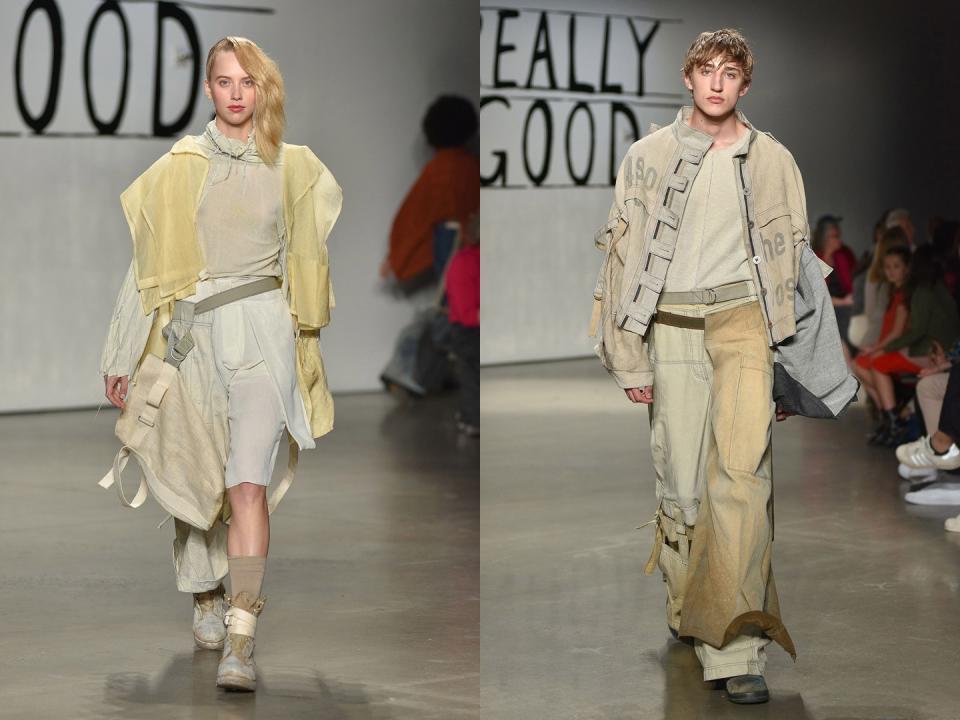
Fiona Conlon, from Viroqua, Wisconsin
School: Pratt Institute
Collection concept: This collection centers around fluidity and transformation; it’s an homage to the unifying force of the ocean and made-from-found, natural, and hand-dyed materials. These pieces metamorphose, as functional components are detached and reapplied. The garments in this collection are in continuous flux, and create an individualized experience and connection.
Most unusual material used? Curtains! I dyed them multiple times in indigo and turmeric baths, and then applied wax to the surface to give the fiber more structure.
What issues are most important to you? The fashion industry has become one of rapid and impulsive consumption. Textile waste is piling up in landfills and releasing harmful chemicals as it decomposes. The mitigation of this waste has been a focus for me as I work to find new ways for transforming excess materials into functional and beautiful garments.
What is the future of fashion? Circular, where pieces are remade and recycled, rather than discarded at the end of their life.
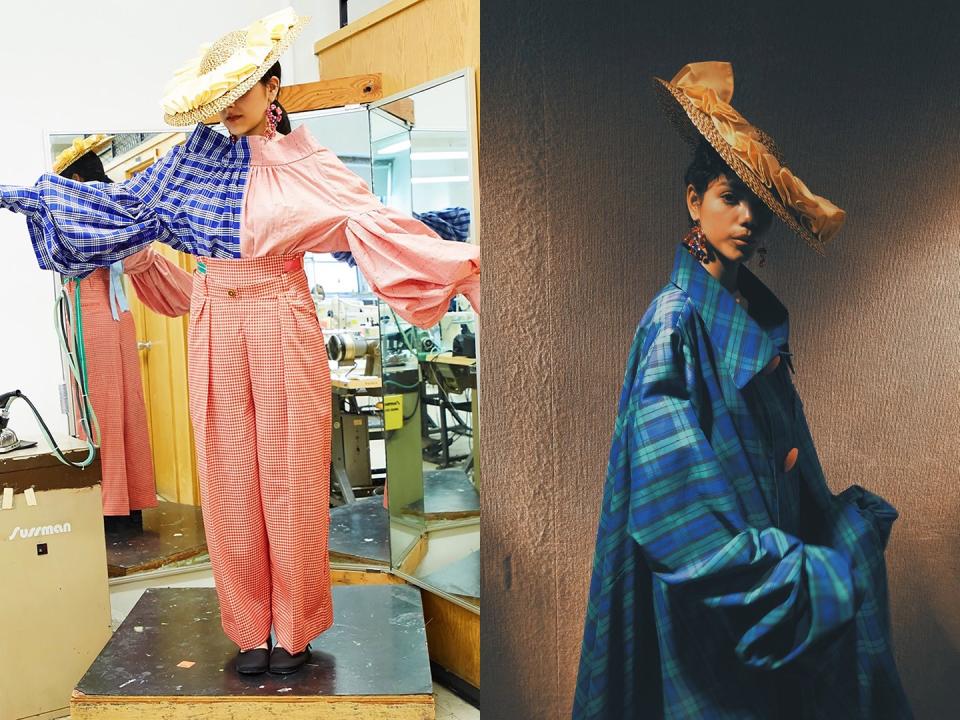
Ishwari Vijh, from Jalandhar, India
School: Fashion Institute of Technology
Collection concept: Every collection starts as a collaged narrative of past events from my life; this particular one explores my love-hate relationship with menswear, and I spruced it up with bits from my old school uniform and elements from a trunk of treasures that I played dress up with as a 10-year-old.
What do you want to communicate through your work? It’s a tough pill to swallow, but there comes a time when you realize that the only people who will appreciate your research and design process will either be students of art or fashion history. For the regular customer, the only thing that matters is how they feel in your clothes. As designers we have so much power to influence people’s self-esteem and confidence. I want everyone who wears my clothes to feel beautiful.
What issues are most important to you? Fair wages for everyone working in the fashion industry. It’s about time the industry stops abusing skilled workers in countries with bad labor laws. All of them deserve to be paid well and not pennies for their skills that literally clothe the world.
Dream job? I would love to start my own brand and be my own boss. I would want to have in-house production, to insure my clothes are made by people who are happy at work.
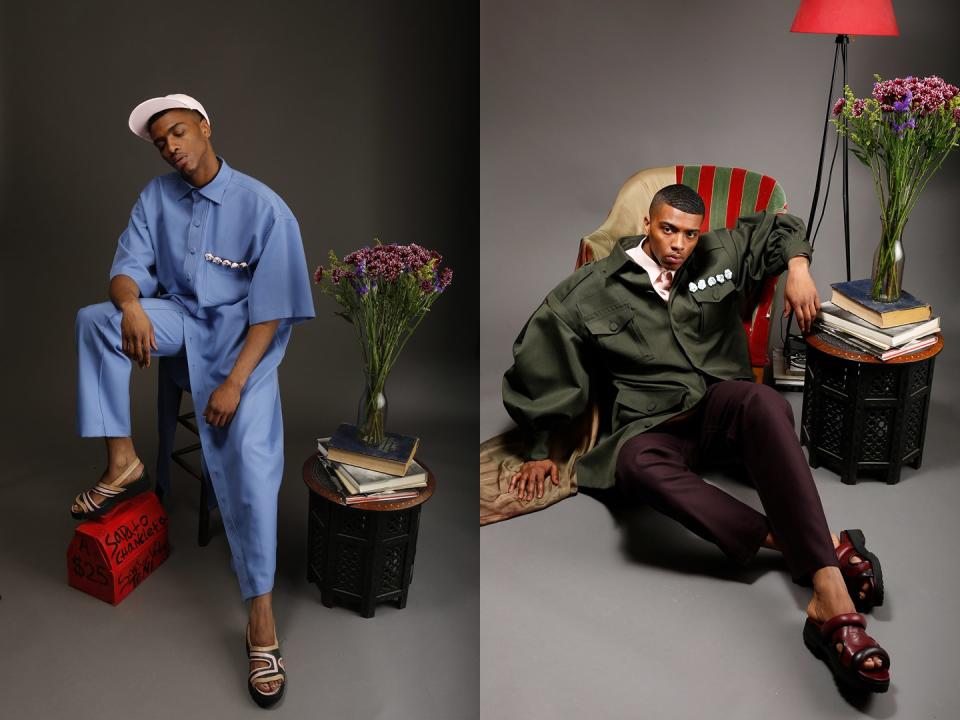
Jose Luis Cabrera Roa, from Santo Domingo, Dominican Republic
School: Parsons School of Design at The New School
Collection concept: My thesis project, Sons of Violence, uses fashion design to engage critical issues of domestic violence against children in the Dominican Republic through a sustainable, fully circular fashion system. My garments deconstruct mythologies of masculinity and violence and reimagine gender and social justice through innovative design and intentional materiality.
Most unusual material used? Sugar from my home country. Using a recipe passed down from my grandmother, I created sugar-flower insignias to represent the innocence that characterizes the victims, children. These flowers feature an aluminum tear to create a metaphor between the violent and the abused.
What do you want to communicate through your work? Through my creative practice I seek to give underdeveloped communities and domestically abused children a voice. As part of my thesis project, I founded a nonprofit organization in the Dominican Republic, Sons of Violence, that works as a circular system with my future clothing brand, ROA, and seeks to provide domestically abused children art therapy in order to improve their lives and support these children and families socially and economically.
What is the future of fashion? I believe it lies in diversity, inclusion, our healthy and responsible interaction with the environment, and contributing to vulnerable communities. My career as a designer is devoted to challenging our current system and finding ways in which fashion can positively contribute to the world.
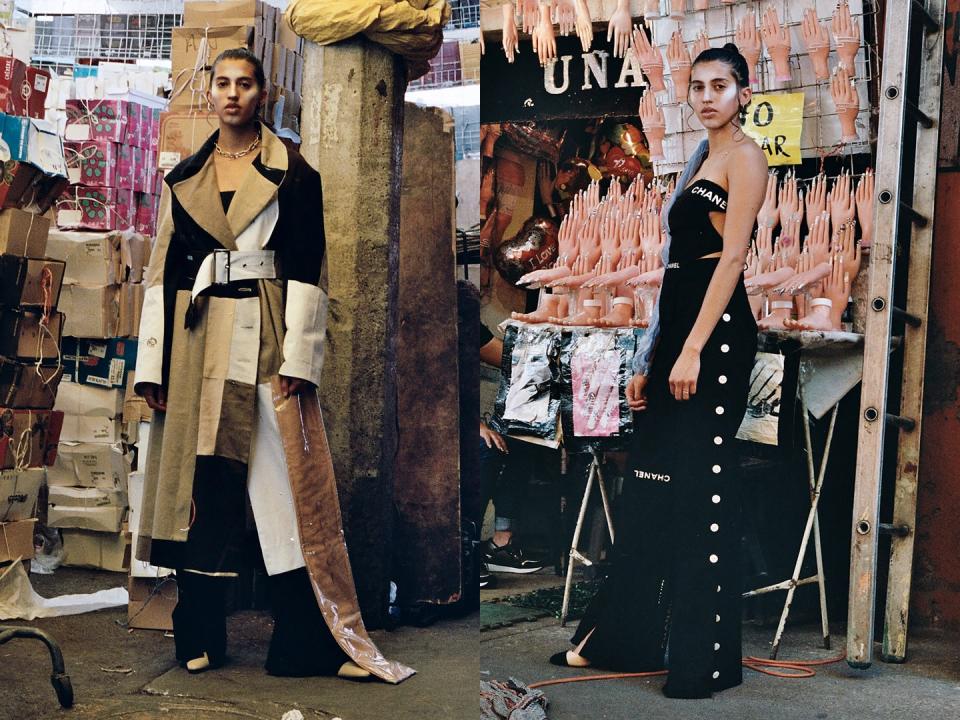
Josefina Muñoz, from Colombia
School: Parsons School of Design at The New School
Collection concept: “No Me Copies” (Don’t Copy Me), deals with the origins of social boundaries and the overall knockoff effect that allows the product to reach populations that generally can’t afford the original. It looks for the democratization of fashion, reshaping the definitions of luxury and value, to consequently debunk hierarchies and break down power structures.
Most unusual material used? Dust bags and garment bags were repurposed into the collection in the spirit of knockoff markets, by mashing up brands which would compete against each other in one same piece. The most unusual material—which is pretty usual—was chicken, obtained through workshop gatherings of universal cultural activities (like eating chicken and drinking coffee). This is to highlight the heritage of both food and fashion.
What do you want to communicate through your work? My main goal is to work towards social sustainability, to recognize that there are hierarchies and to bring them down. I’m a believer in a system that can nurture multiple users from different socioeconomic standings without privileging some more than others. My work revolves around the ideas of decolonization of knowledge and authority, by creating designs that allow users to reshape their role in society without being complacent about how the current systems place them.
What’s next? I’ve been working with artisan communities in Colombia for two years now, and I find this is a good middle point for fashion and social innovation. After graduation, I plan on continuing “No Me Copies” as a movement. The third iteration of the workshop “Comer Pollo y Tomar Café” (Eating Chicken and Drinking Coffee) will take place at Art Basel Switzerland, and hopefully the fourth one can be done remotely, being guided by the manifesto and the ideas of this project, to begin a movement of justice and equality.
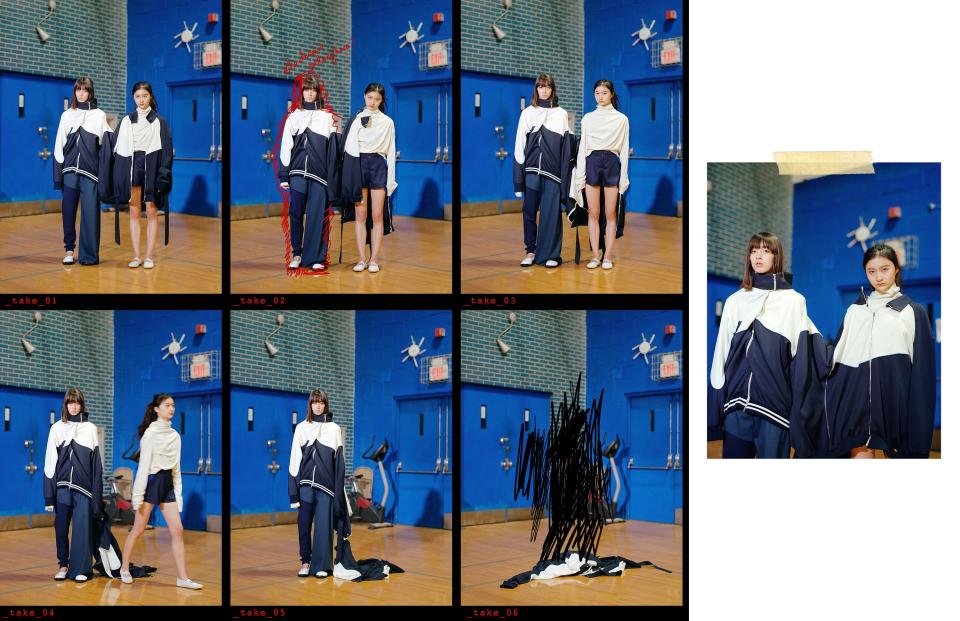
Kyra (Jingyi) Feng, from Beijing School: Pratt Institute
Collection concept: As a victim of school bullying, I wanted to address this problematic issue and I’ve [worked my] personal experience into my collection.
Most unusual material used: I developed a “grabbing-shirt” print, and a scanned print of old uniform skirt.
What issues are most important to you? Right now, school bullying, and how Chinese culture is being interpreted.
What is the future of fashion? [I believe it’s a] medium that can push toward a better future.
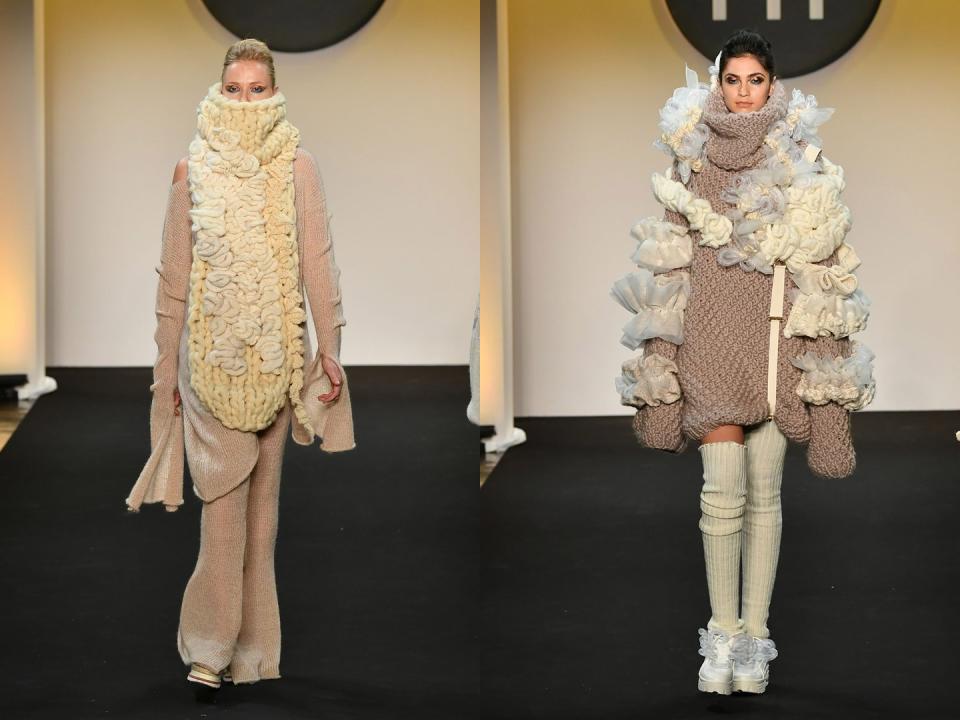
Loucine Tahmasian, from Los Angeles School: Fashion Institute of Technology
Collection concept: Sometimes we have to selectively layer complexity into our lives and take on the challenge of the unknown. Most often, adding complexity means making choices that might seem impossible at the time but have the potential of improving our future by a large magnitude.
What do you want to communicate through your work? My work is an accumulation of personal emotions and encounters that I have in life. I aim to break free from traditional rules and create without boundaries, which will allow me to design garments [that are] unusual, igniting a sense of wonder.
What issues are most important to you? Sustainable fashion.
What is the future of fashion? It’s unpredictable, however I do believe fashion is viewed as more of an art form now and that is going to lead designers on a path of creative freedom.
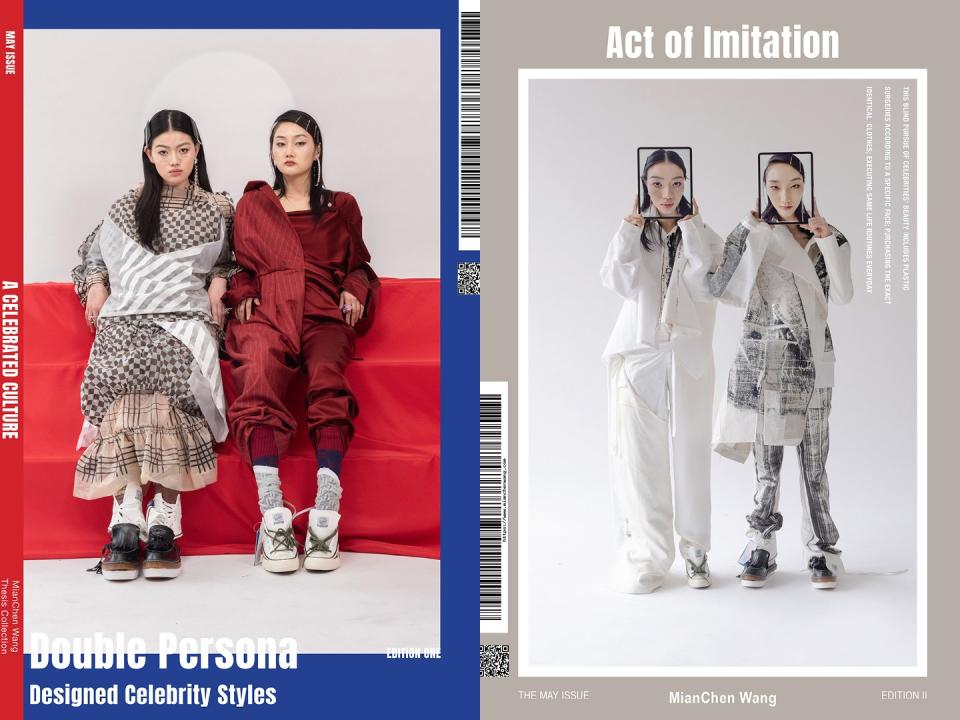
Mianchen Wang, from Beijing
School: Parsons School of Design at The New School
Collection concept: This thesis collection is about celebrity culture in China and how it influences and controls consumers’ fashion choices. Fans’ imitation behavior, celebrity selfies, social events, and Taobao (operated by Alibaba) are the four main directions I studied throughout my collection.
What do you want to communicate through your work? My work uses social media’s own language to raise awareness and to reclaim the natural diversity of people’s own fashion choices.
What issues are most important to you? I think a lot of things in Chinese society are problematic and also interesting for further exploration. However, after graduation, my plan is to focus more on solving environmental issues caused by the fashion industry.
What is the future of fashion? Many industries have changed their rules, but fashion hasn’t done much. For me, sustainable and interactive materials will be the subject that more and more new designers are going to study.
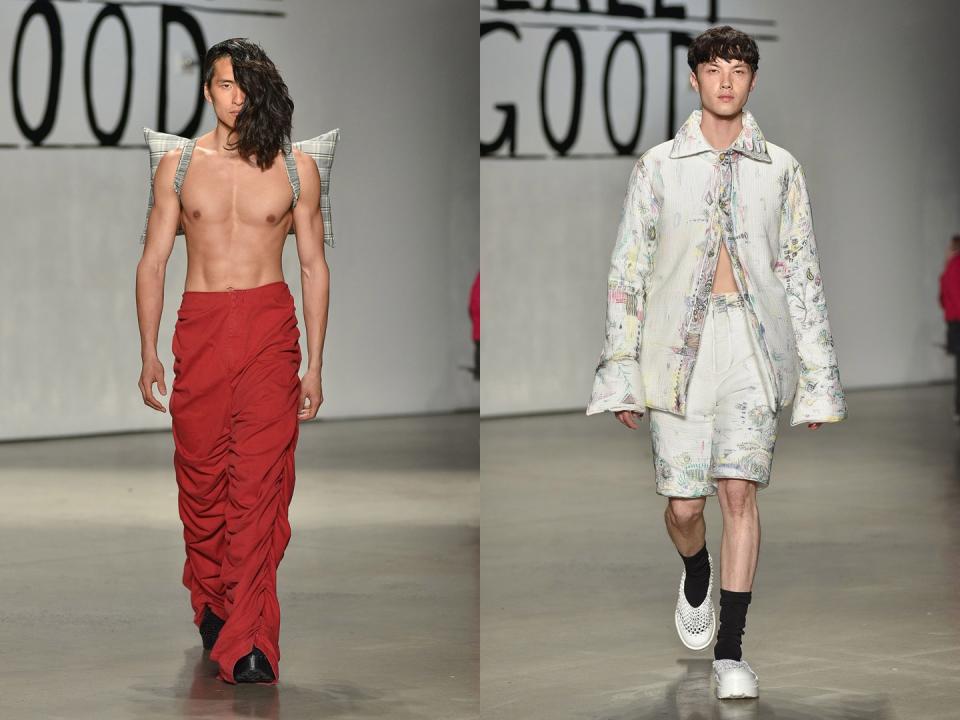
Ruojing Wang, from Dalian, China
School: Pratt Institute
Collection concept: My collection is about sleep. It is the result of an unfortunate nerve injury that occurred due to lack of sleep. I had pulled two all-nighters in the studio and fell asleep in class, leaning my entire body weight against my right arm and damaging my radial nerve. For five months I was unable to even hold up a pair of scissors. I really thought I was never going to recover. I want everyone to learn from my experience and sleep more!
What issues are most important to you? Being a foreigner in America, it is hard to watch the progress in human rights others fought so hard for being backtracked and feeling so powerless. That has been on my mind a lot lately, and I hope what I create can make an impact on this situation.
What do you think the future of fashion is? Sustainability. Technology in the way textiles are made and the way garments are engineered to create less waste. Secondhand and vintage.
What’s next? My friend Tony Tafuro and I collaborated on the hand-drawings on a puffer set and some printed knit accessories for this collection, and we are planning [on working together more].
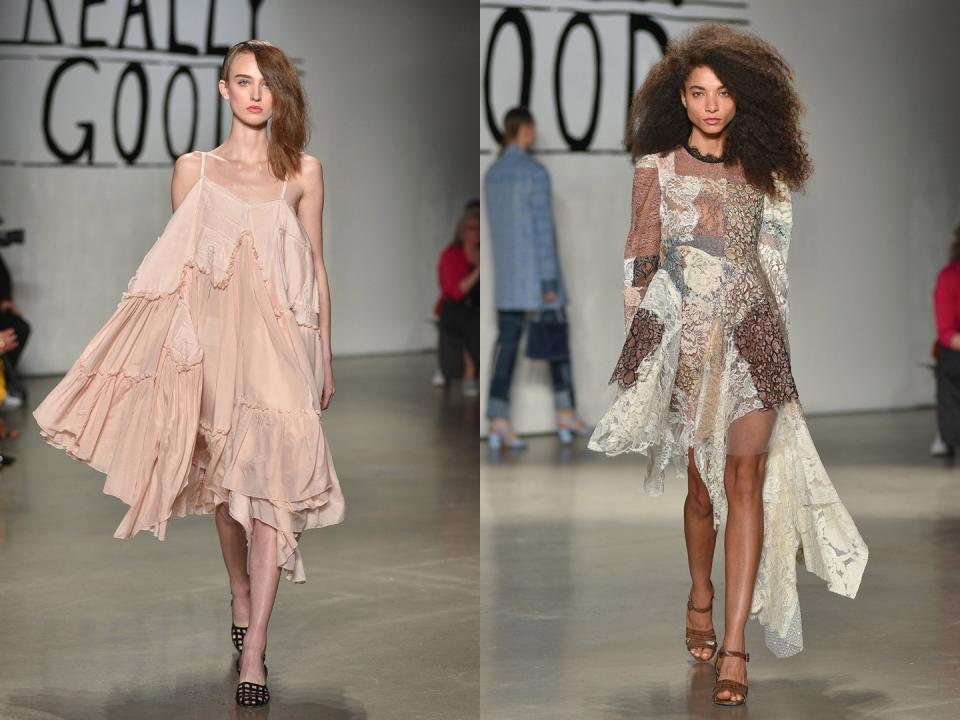
Xarea Lockhart, from Windsor, Connecticut
School: Pratt Institute Collection concept: “Pieces of Me,” is inspired by quilts my grandma used to make growing up in Alabama. I wanted to take the techniques and traditions these quilts embodied and reinterpret them through textiles and silhouette.
Most unusual material used? A blue jacket was constructed from a cool, old tablecloth my grandma found in her basement! Also, all the lace garments are made from old textile headers donated to me by Solstiss Lace; I bonded them together to create my own textile.
What do you want to communicate through your work? The love I experience and feel within my family inspired my collection. As a woman of color, it is important to hear more stories of love and light come out of my community.
What is the future of fashion? For any future to be guaranteed at all, we have to really change gears and aim for a more sustainable and ethical industry. The need is there for smaller runs, fewer seasons, better allocation of materials, and treating the hands that make our products better.
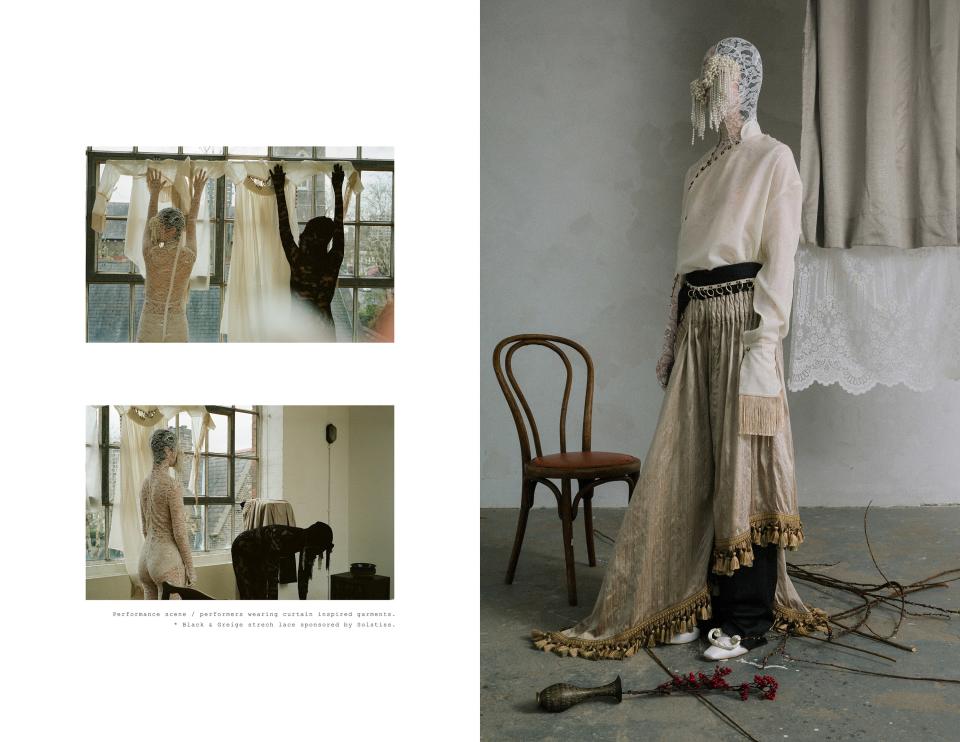
Yayi Chen, from China, raised in Madrid
School: Parsons School of Design at The New School
Collection concept: “In Tran·sient” is a collaborative collection of fashion and performance that aims to question the overlooked and objectified laboring body of women in the Chinese immigrant community in Europe. It also explores the poetic relationship between immigrant women’s invisible social identity and their impermanent working space, through transforming symbolic objects from Chinese restaurant interiors into wearable garments.
What do you want to communicate through your work? I combine fashion and performance art through a collaborative process with a community of fine artists from the same diasporic background as mine. I aim to use our collective voice to empower the immigrant women that still remain invisible today, not only in Western society, but also in individual immigrant family systems.
What issues are most important to you? My research and creation often focus on women’s identity in society throughout history within multicultural contexts.
What is the future of fashion? In terms of humanity, I believe fashion has the burden of being socially responsible, reflective, and sustainable. I foresee future fashion systems being largely influenced and controlled by technological innovations and social media impact. I wish these two aspects of development could reach a balance to ultimately enrich both the social, cultural, and artistic value of fashion design.
These interviews have been edited and condensed.
Originally Appeared on Vogue

